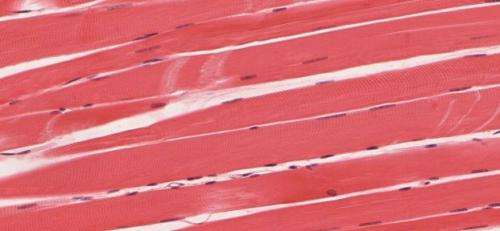
The older we grow, the weaker our muscles get, riddling old age with frailty and physical disability. But this doesn’t only affect the individual, it also creates a significant burden on public healthcare. And yet, research efforts into the biological processes and biomarkers that define muscle aging have not yet defined the underlying causes.
Now, a team of scientists from lab of Johan Auwerx at EPFL’s School of Life Sciences looked at the issue through a different angle: the similarities between muscle aging and degenerative muscle diseases. They have discovered protein aggregates that deposit in skeletal muscles during natural aging, and that blocking this can prevent the detrimental features of muscle aging. The study is published in Cell Reports.
“During age-associated muscle diseases, such as inclusion body myositis (IBM), our cells struggle to maintain correct protein folding, leading these misfolded proteins to precipitate and forming toxic protein aggregates within the muscles,” explains Auwerx. “The most prominent component of these protein aggregates is beta-amyloid, just like in the amyloid plaques in the brains of patients with Alzheimer’s disease.”
In the study, the scientists identify amyloid-like protein aggregates in aged muscles from different species, from the nematode C. elegans all the way to humans. In addition, they also found that these aggregates also impair mitochondrial function. Although aggregated proteins have been suggested to contribute to brain aging, this is the first time that they have been shown to contribute to muscle aging and to directly damage mitochondria. “These abnormal proteotoxic aggregates could serve as novel biomarkers for the aging process, beyond the brain and muscle,” says Auwerx.
But can the formation of the protein aggregates be reversed? To answer this, the researchers fed worms the vitamin nicotinamide riboside and the antitumor agent Olaparib, both of which boost the levels of nicotinamide adenine dinucleotide (NAD+), a biomolecule that is essential for maintaining mitochondrial function, and whose levels decline during aging.
In the worms, the two compounds turned on the defense systems of the mitochondria, even when provided at advanced age. Turning on the so-called “mitochondrial quality control system” reduced the age-related amyloid protein aggregates and improved the worms’ fitness and lifespan.
The scientists then moved on to human muscle tissue, taken from aged subjects and IBM patients. Turning on the same mitochondrial quality control systems produced similar improvements in protein and mitochondrial homeostasis. The encouraging results led the researchers to test nicotinamide riboside in aged mice. The treatment also activated the mitochondrial defense systems and reduced the number and size of amyloid aggregates in different skeletal muscle tissues.
Source: Read Full Article
